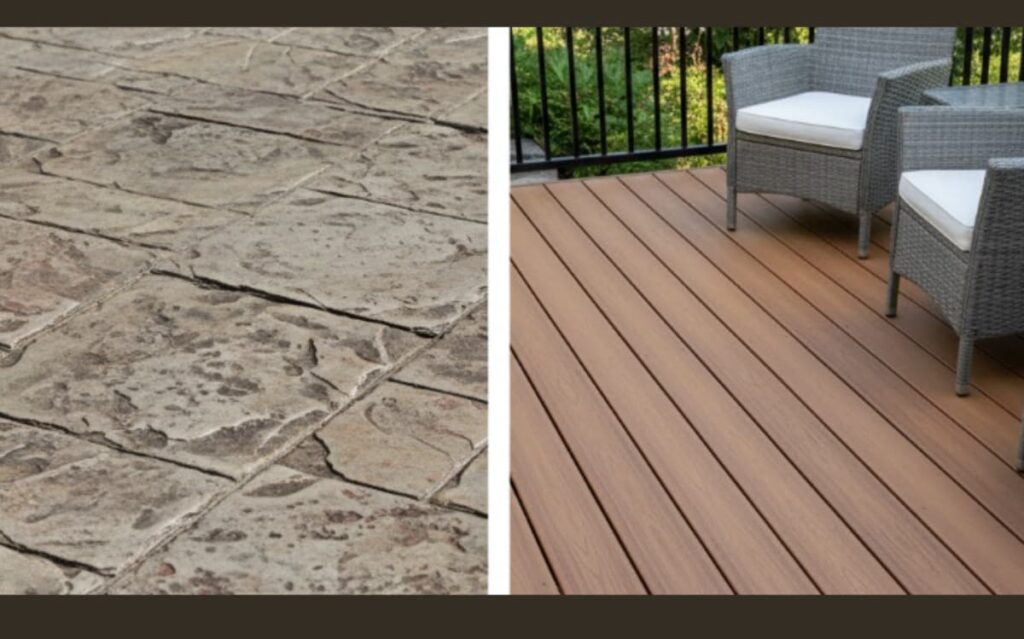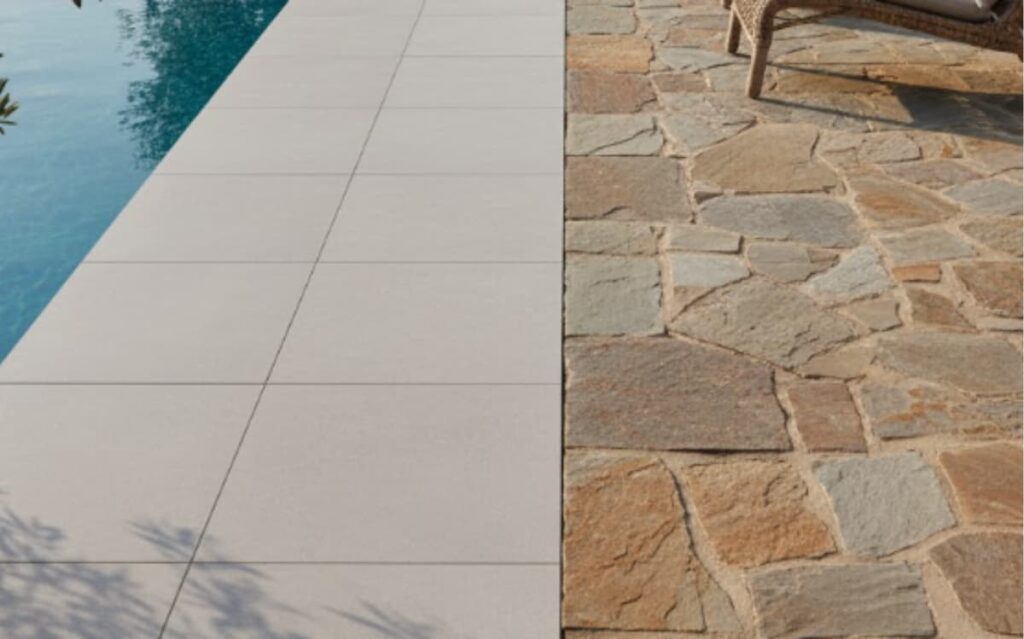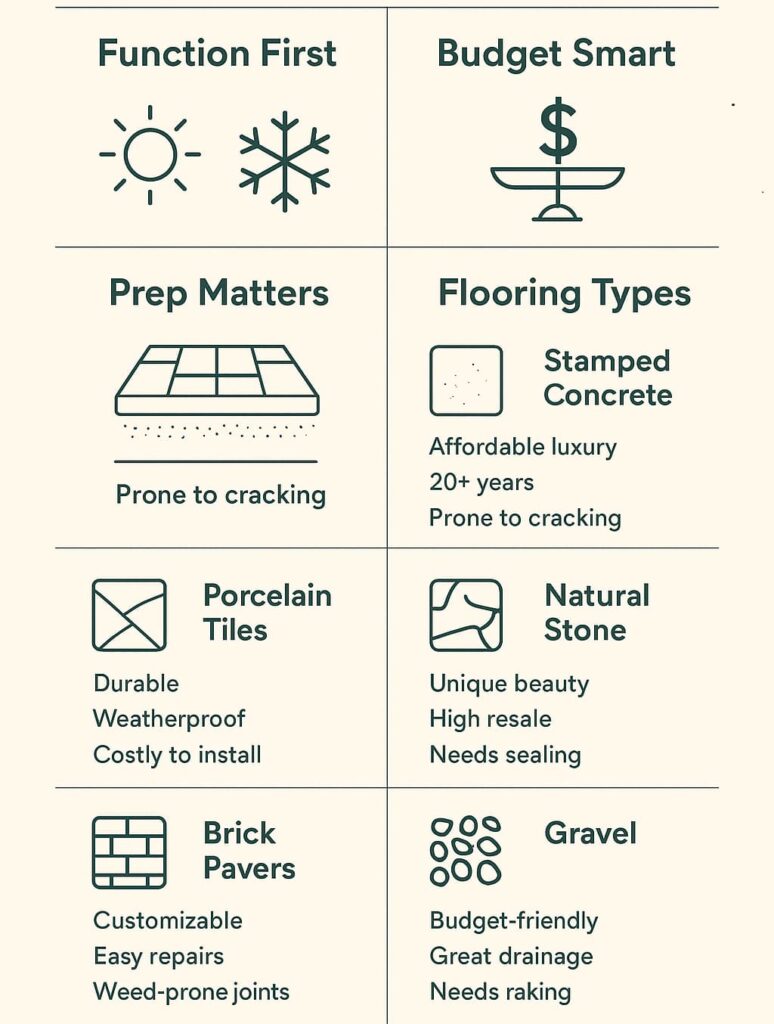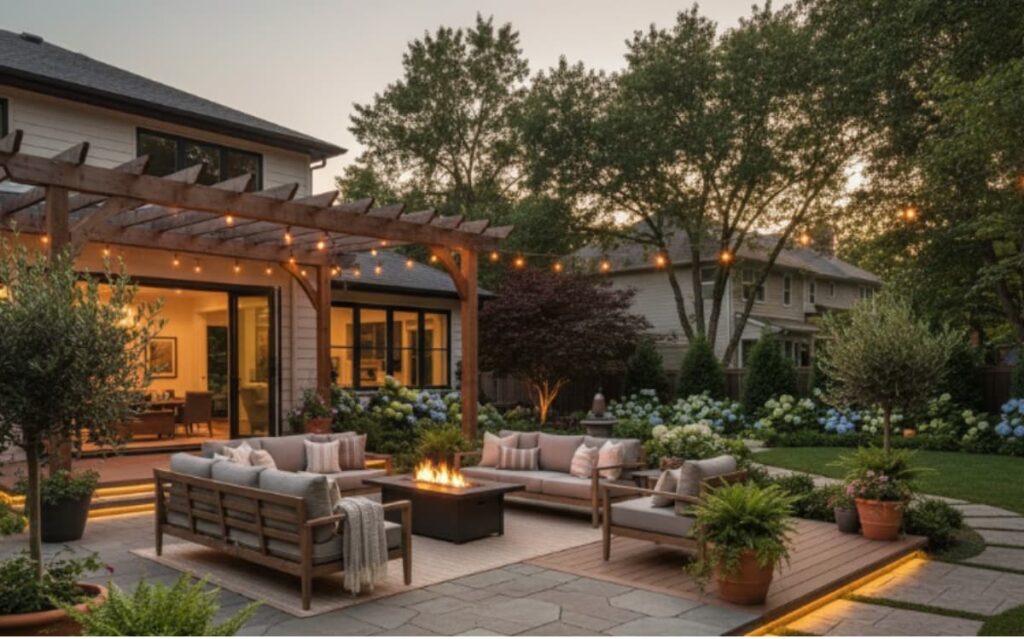Discover the best outdoor flooring for your patio. Our guide reviews concrete, composite, tile, stone, and pavers to help you choose the perfect, durable option.’
Choosing the right outdoor flooring for patios isn’t rocket science, but it does require careful thought about what works for your specific setup. Some homeowners swear by natural stone’s rugged charm, while others prefer the set-it-and-forget-it nature of composite decking.
There’s concrete pavers too – they’re sort of the middle ground between fancy and functional. We’ve spent the last 10+ years installing patios across Charlotte and Lake Wylie, and honestly?
The perfect patio floor doesn’t have to break the bank or your back with maintenance. It just needs to handle whatever Mother Nature (and your family) throws at it.
Whether you’re dreaming of barefoot-friendly surfaces or something that’ll make the neighbors do a double-take, we’ll walk you through the options that actually make sense for Carolina homes.
Key Takeaways
- Real Talk About Function: Your patio floor needs to handle both scorching summers and occasional ice storms. Pick something that matches how you’ll actually use the space, not just what looks good on Pinterest.
- Budget Matters: Some materials cost an arm and a leg upfront but barely need maintenance. Others are cheaper to install but might need more TLC down the road. Think about both when planning your budget.
- Don’t Skip the Prep Work: Even the fanciest materials will fail without proper installation. Good drainage and a solid foundation aren’t exciting, but they’re what keep your patio looking great years later.
Stamped or Stained Concrete
What is Stamped or Stained Concrete?
Think of stamped concrete as the chameleon of patio materials – it’s basically regular concrete that gets dressed up while it’s still wet [1]. The crew presses patterns into it (kind of like making designs in wet sand), and they can make it look like just about anything: brick, stone, even wooden planks if that’s your thing.
Some people go a step further and add stains, which soak into the concrete and give it these really nice, natural-looking colors. We’ve done hundreds of these patios around Charlotte, and they’re perfect for homeowners who want that high-end look without emptying their savings account.
Key Features and Benefits
After working with stamped concrete for years, here’s what makes it stand out from other options:
- Mix-and-Match Design: You can pretty much create whatever look you want. Some of our clients go for that classic brick look, while others prefer something more modern. The pattern and color combos are practically endless.
- Tough as Nails: Once it’s properly installed and sealed (this part’s crucial), stamped concrete can handle everything from the weight of durable patio furniture to your kid’s basketball bouncing on it.
- No Green Stuff Growing Through: Unlike individual pavers or stones, there aren’t any gaps for weeds to sneak through. Just spray it down with the garden hose now and then, maybe scrub it once a year.
- Won’t Empty Your Wallet: You’re getting the look of expensive stone or brick, but you’re paying concrete prices. Plus, installation’s usually quicker, which means lower labor costs.
Pros and Cons
Let’s be straight about stamped concrete – it’s got some real strengths, but it’s not perfect (nothing is). Here’s what we’ve seen after installing hundreds of these patios:
Pros:
- Easy on the Wallet: You’ll spend way less than you would on natural stone or pavers, but still get that fancy look.
- Design Freedom: Want it to look like Italian slate? Done. Brick? No problem. Your imagination’s pretty much the limit here.
- Built to Last: Put it in right, and you’re looking at 20+ years before any major issues pop up.
Cons:
- Yeah, It Might Crack: Nature is nature – especially in Carolina winters when temps bounce around freezing. Cracks happen.
- Patch Jobs Are Tricky: If something does crack, matching the original color’s about as fun as finding a needle in a haystack.
- Watch Your Step: These surfaces can get slippery after rain. We usually mix in some gritty stuff in the sealer to help with that.
Is Stamped Concrete Right for You?
If you’re nodding along to most of these points, stamped concrete might be your best bet: You want something that looks expensive but isn’t. You’d rather spend weekends enjoying your patio than maintaining it.
And you’re done with fighting weeds popping up between pavers. Just remember – no material’s perfect, but stamped concrete hits that sweet spot between looks, function, and cost for most Carolina homes.
Composite Decking

What is Composite Decking?
Back in the 90s, decks meant wood [2] – solid, traditional, but kind of a pain to maintain. Then someone got smart and mixed sawdust with melted plastic. That’s composite decking.
It’s not perfect (nothing really is), but it’s tough enough to handle snow, rain, and whatever else nature throws at it. Maybe best of all? No more weekends lost to sanding or treating deck boards that keep warping.
Key Features and Benefits
After twenty-plus years of improvements, composite decking’s gotten pretty good at what it does.
The main stuff worth knowing:
- Less Work: Skip the yearly refinishing routine. A garden hose and some dish soap do the job.
- Holds Up: Doesn’t rot, split, or turn into a splinter factory. Stays solid even after years of summer cookouts.
- Looks Right: Boards come in loads of colors – some even have grain patterns that could pass for maple or oak.
- Green Choice: Uses recycled junk – old plastic bags, wood scraps from sawmills. Keeps that stuff out of dumps.
Pros and Cons
Nothing’s perfect – even composite decking comes with its good and bad points. Better to know these before spending money on boards.
Pros:
- Skip the Work: No more yearly staining or sealing. Saves around $850 each year in maintenance costs.
- Lasts Forever: Most boards stick around 25-30 years without falling apart.
- Bugs Don’t Like It: Termites can’t eat it, carpenter ants move on to other places.
Cons:
- Costs More Up Front: About $8-12 per square foot versus $4-6 for regular wood.
- Gets Hot: Dark colored boards in July sun? Better wear shoes.
- Can Get Marked Up: Drop something sharp or drag the grill? Might leave a mark.
Is Composite Decking Right for You?
Think about what matters most – saving time or saving money now. Sure, composite costs more today, but divide that cost over 25 years. Factor in never buying stain or sealant again. Skip the pressure washer rental every spring. Just remember – composite won’t feel exactly like wood underfoot, and it’ll cost more now. But tomorrow? That’s when the real savings kick in.
Outdoor-Rated Porcelain Tiles

What are Outdoor-Rated Porcelain Tiles?
Back when patios meant concrete slabs or wooden decks, someone started using porcelain tiles outside. Not regular bathroom tiles – these are different. They’re baked at 2200°F until they’re hard as rock. The heat makes them dense, like tiny fortresses that water can’t get into. That matters when winter hits and regular tiles would crack from frozen water stuck inside. Now they’re showing up everywhere, from fancy restaurant patios to backyard spaces.
Key Features and Benefits
After years in the field, these tiles have proven they’re not just a passing trend.
Here’s what makes them work:
- Built Strong: Drop a wrench, drag a chair – these tiles don’t flinch. Some can handle 2000 pounds before cracking.
- Handles Weather: Rain rolls right off. Sun won’t fade them. Winter freezes? No problem.
- Looks How You Want: Thanks to better manufacturing, they can look like marble, wood, even metal. Some fool expert stone masons.
- Easy to Keep Clean: Spill something? Wipe it up. Mud? Hose it off. No special cleaners needed, no sealing required.
Pros and Cons
Time to weigh the good against the bad with outdoor porcelain tiles.
Pros:
- Tough as Nails: Stands up to scratches, impacts, and heavy stuff. Most last 50+ years.
- Shrugs Off Water: Perfect next to pools or in rainy spots. Wine spills? Wipes right off.
- Lots of Looks: From basic gray to fancy marble patterns. Some cost less than real stone.
Cons:
- Gets Slick: Regular tiles turn into slip-n-slides when wet. Need rough-finish ones rated for outdoors.
- Not a DIY Job: Takes skill to install right. Bad installation means cracked tiles in winter.
- Costs Add Up: Figure $15-30 per square foot installed. That’s twice what concrete costs.
Are Porcelain Tiles Right for You?
Think about the space. Got a pool deck that’s always wet? An outdoor kitchen where stuff spills? These tiles handle that mess. Sure, they cost more to put in, but they last decades without much fuss. Just don’t skimp on installation – one frozen winter with poorly laid tiles means starting over. And make sure to get the rough-finish kind meant for outdoors.
Natural Stone (Travertine, Slate, Flagstone)

What is Natural Stone Flooring?
Stone’s been around since before anyone thought about patios. Travertine, slate, flagstone – each piece comes straight from the ground, cut and shaped. No factory patterns here. Travertine keeps cool even in August heat. Slate runs dark and moody. Flagstone? Rough edges and natural shapes that look like they grew right out of the yard. Each stone tells its own story through swirls, spots, and streaks that took millions of years to form.
Key Features and Benefits
Stone’s got something manufactured stuff just can’t match.
Take a look at what makes it special:
- One of a Kind: Every single piece has its own pattern. Nature doesn’t do copies.
- Built to Last: These stones have survived millions of years underground. A few decades on a patio? No sweat.
- Beats the Heat: Light-colored stones like travertine stay cool enough for bare feet, even in direct sun.
- Worth Something: When it comes time to sell, stone patios often return 80% or more of what was spent.
Pros and Cons
Stone’s beautiful, but let’s be real about what you’re getting into.
Pros:
- Looks Amazing: No two stones match – Mother Nature doesn’t work that way.
- Lasts Forever: These stones hung around for millions of years. They’ll outlast the house.
- Stays Cool: Walk barefoot on travertine in July? No problem. Unlike concrete that burns feet.
Cons:
- Costs a Fortune: Expect to pay $20-30 per square foot installed. That’s before any fancy patterns.
- Needs Work: Most stone soaks up wine, oil, even water. Plan on sealing it every 2-3 years.
- Not Always Flat: Natural means bumpy. Tables might wobble unless you pick smoother cuts.
Is Natural Stone Right for You?
Stone’s not for everyone. It costs more than most materials – sometimes three times more than concrete. But nothing else has that natural magic. Those swirls and colors took millions of years to form. Just remember: sealing it takes time, cleaning needs gentle soaps, and the surface might not be pool-table flat. But done right? That patio becomes the heart of the yard, aging gracefully year after year.
Brick and Concrete Pavers
What are Brick and Concrete Pavers?
Pavers are individual units, made from either clay (brick) or concrete, that interlock to create a patterned surface. Brick pavers offer a classic, timeless look with rich colors that don’t fade. Concrete pavers are manufactured in a vast array of shapes, sizes, and colors, offering incredible design flexibility. Our team at Lapis Patios specializes in paver installations, and we’ve seen firsthand how they can completely transform a backyard. The ability to create custom designs, from classic herringbone to intricate circular patterns, is what makes pavers such a versatile and popular choice.
Key Features and Benefits
Pavers are a tried-and-true choice for patio flooring, offering a superb combination of beauty, strength, and practicality you can depend on.
These are the features our clients find most appealing:
- Design Flexibility: The variety of paver shapes and colors allows for endless design possibilities, from simple layouts to complex mosaics.
- Durability and Strength: Pavers create a strong, interlocking surface that can handle heavy traffic and furniture.
- Easy Repairs: This is a major advantage. If a single paver gets damaged, you can simply lift it out and replace it, which is much easier than patching a cracked concrete slab.
- Good Drainage: The joints between pavers allow water to permeate the base below, which helps prevent standing water.
Pros and Cons
Pavers are a fantastic all-around option, but it’s helpful for you to know both sides of the story before making a commitment.
Pros:
- Highly Customizable: A huge range of styles and colors to match any aesthetic.
- Repairable: Damaged sections can be easily and seamlessly replaced.
- Classic Aesthetic: Brick, in particular, offers a timeless charm that complements many homes.
Cons:
- Potential for Weeds: Weeds can sometimes grow in the sand-filled joints, though using polymeric sand helps minimize this.
- Requires a Stable Base: The longevity of a paver patio is entirely dependent on the quality of the base preparation to prevent sinking or shifting.
- Can Settle Over Time: After many years, some pavers may settle, potentially requiring minor re-leveling.
Are Pavers Right for You?
Pavers are an excellent outdoor flooring choice for you if you value design flexibility and long-term repairability. They offer a more upscale look than basic concrete without the high cost of natural stone. If you love the idea of creating custom patterns, pavers provide the perfect canvas. For a durable, beautiful, and adaptable patio surface, brick or concrete pavers are one of the best all-around options available.
Gravel
What is Gravel Flooring?
Gravel flooring, typically using pea gravel, is a patio surface made from loose, small stones. It creates a casual, natural-looking space and is one of the most budget-friendly materials available. Installation involves preparing the ground, laying a weed barrier, and spreading a layer of gravel contained by a sturdy edging. While we focus on permanent hardscapes, we appreciate the rustic charm of a gravel patio for secondary spaces like a garden seating area or a fire pit zone.
Key Features and Benefits
For a relaxed and affordable patio, gravel offers a unique set of advantages that you might find appealing for specific projects.
Here are the primary features of gravel:
- Affordability: Gravel is one of the least expensive outdoor flooring materials you can buy.
- Excellent Drainage: Water flows freely through the stones, eliminating any issues with standing water.
- Easy DIY Installation: Creating a gravel patio is a straightforward project that many homeowners can tackle themselves.
- Natural, Rustic Look: Gravel provides a soft, organic texture that blends seamlessly into a garden setting.
Pros and Cons
Gravel is a simple solution, but its unique nature brings specific pros and cons that you should carefully consider for your space.
Pros:
- Very Low Cost: The most budget-friendly patio surface available.
- Superb Drainage: You’ll never have to worry about puddles.
- Easy to Install: A great option for a DIY-friendly project.
Cons:
- Unstable Surface: It can be difficult to walk on, and it’s not a stable surface for most patio furniture.
- High Maintenance: Requires regular raking to keep it level and free of leaves and debris.
- Weed Growth: Despite a weed barrier, weeds can eventually find their way through.
Is Gravel Right for You?
A gravel patio could be right for you if you’re looking for an extremely low-cost, informal solution for a secondary outdoor area, like a fire pit zone or garden path. However, it is generally not ideal as a primary patio surface for dining or entertaining due to its unstable surface.
Choosing the Right Flooring: Key Considerations
Picking outdoor flooring comes down to more than what catches your eye. After five years watching Charlotte and Lake Wylie homeowners create their dream patios, here’s what actually matters.
Budget
Budget matters. Basic gravel runs about $6 per square foot installed. Natural stone? Could hit $30. That adds up fast on a 400-square-foot patio. Don’t forget the hidden costs – sealing stone every few years, replacing damaged pavers, refinishing concrete.
Aesthetics
The floor sets the mood. Want that cabin-in-the-woods feel? Rough-cut flagstone does that. Going for modern clean lines? Those 24×24 porcelain tiles nail it. Just make sure it doesn’t fight with your house’s style. A sleek modern patio looks weird next to a colonial brick home.
Climate
Around here, summer sun bakes everything. Dark pavers turn into foot-burners by August. Then winter hits with those freeze-thaw cycles that crack weak materials. Near pools? Smooth tile turns deadly slick when wet.
Maintenance
Be honest about upkeep. Some folks don’t mind spending spring weekends sealing stone. Others want to grab a beer and enjoy their yard. Composite decking needs just soap and water. Natural stone? Plan on work every season.
Intended Use
Think about real life. Hosting weekly cookouts? Those fancy limestone tiles might stain from spilled wine. Kids splashing by the pool? Need something grippy when wet. Want to set up the dining table? Better have a dead-level surface.
Final Recommendations
After ten years working with Charlotte homeowners, here’s what really works in outdoor flooring.
Trying to get that custom look without breaking the bank? Stamped concrete and concrete pavers hit that sweet spot. Stamped concrete flows like one big canvas. Pavers? Pop out the damaged ones, drop in new ones – done. Both handle our Carolina weather without flinching.
Want to forget about maintenance? Look at composite decking or those outdoor porcelain tiles. Sure, they cost more up front. But skip the yearly sealing ritual, forget about pressure washing every spring. Just grab the garden hose when they get dirty.
Here’s the thing about patios – doesn’t matter what goes on top if what’s underneath isn’t right. Good base prep beats fancy materials every time. That’s why we dig deep, grade right, and compact properly. No shortcuts.
Think it’s time to turn your backyard into something special? Contact Lapis Patios. We’ll walk through what works for your space, your style, your budget. No pressure, just straight talk about getting it done right.
References
- https://www.thespruce.com/how-to-stain-concrete-7483499
- https://en.wikipedia.org/wiki/Composite_lumber

